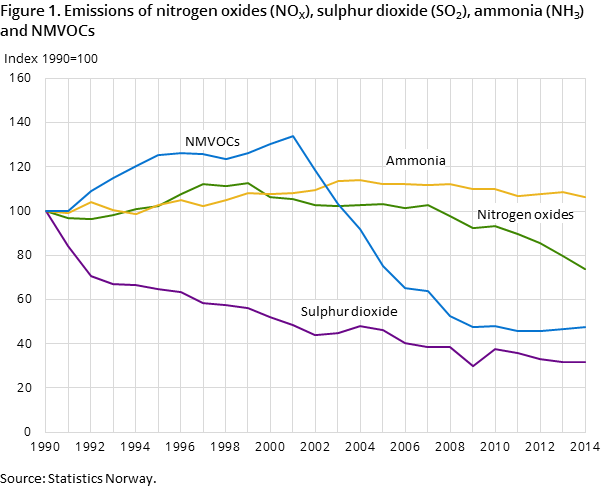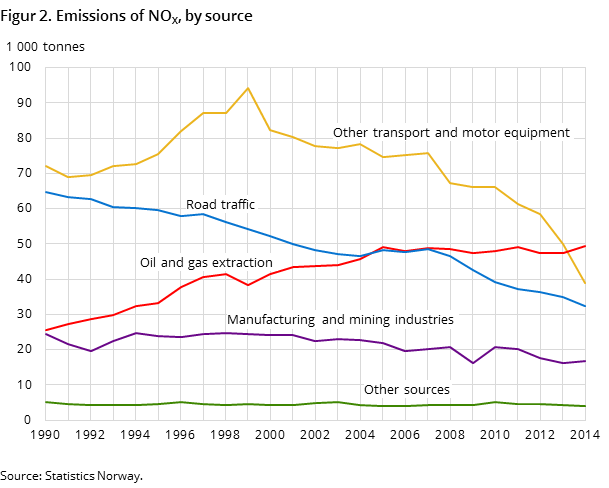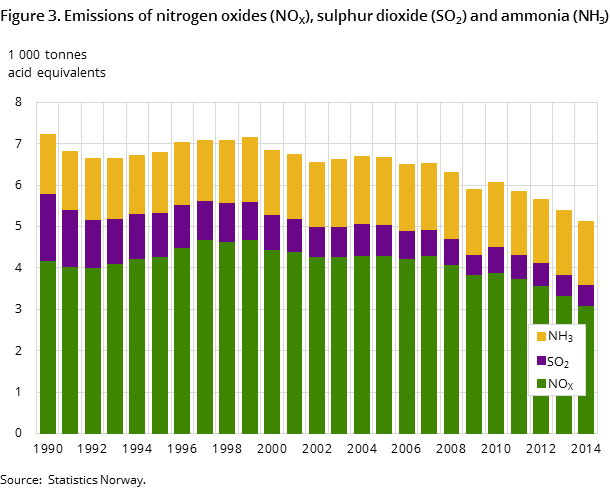Content
Published:
This is an archived release.
Ammonia emissions still exceeding obligations
Norway has reached the international targets on reduction of emissions of acidifying gases and ozone precursors, with the exception of ammonia. Agriculture is the main source for this gas, and ammonia emissions have been relatively stable since 1990.
| 2014 | Change in per cent | ||
|---|---|---|---|
| Since 1990 | 2013 - 2014 | ||
| 1Does not include international sea and air traffic. | |||
| Nitrogen oxides (NOX) | 142 | -26.2 | -7.3 |
| Sulphur dioxide (SO2) | 17 | -68.1 | -0.2 |
| Ammonia (NH3) | 26 | 6.4 | -1.9 |
| Non-methane volatile organic compounds (NMVOC) | 139 | -52.3 | 2.4 |
| Carbon monoxide (CO) | 244 | -67.4 | -7.8 |



These are the results from the most recent emission estimates for 2014. Information is now available at a more detailed level, and estimates are given for several sources and sectors.
Above emission ceiling for ammonia
Emissions of ammonia (NH3) can cause acidification and eutrophication. Through the revised Gothenburg Protocol, Norway has committed to a reduction of these emissions of 8 per cent by 2020 compared with emissions in 2005. Nearly 26 000 tonnes of ammonia were emitted in 2014. This is a 5 per cent reduction compared with 2005 and 3 per cent above the target for 2020.
Storage and handling of manure in the agricultural sector is the dominant source of Norwegian ammonia emissions. These emissions have only been subjected to minor changes since 1990.
Nitrogen emissions from activities at sea still decreasing
Emissions of nitrogen oxides (NOX) have decreased substantially in the last few years, mainly due to the introduction of a tax on these emissions in 2007. The tax has led to improvements in motor efficiency and the application of cleaning technology in ships, and therefore important reductions in NOX emissions from activities at sea. A total of 142 000 tonnes of NOX were emitted in 2014, more than 7 per cent less than the previous year. The reduction means that Norway reached the 2020 emission target for NOX in 2014.
Small increase in NMVOC emissions
About 139 000 tonnes of volatile organic carbon, NMVOC, was emitted in 2014, which is well below the current international target, but 6 per cent above the target for 2020. The emissions mainly stem from the use of products containing NMVOCs and oil and gas extraction.
The 2.4 per cent growth in emissions from 2013 to 2014 was a consequence of increased consumption of natural gas in the oil and gas extraction industry. Nevertheless, the NMVOC emissions from this sector in 2014 were only one sixth of the emissions in 2001. The emissions from the use of products, on the other hand, have seen no substantial changes in the emission level over the same time period.
Steady sulphur emissions
Nearly 17 000 tonnes of sulphur dioxide (SO2) were emitted in 2014; about the same level as in 2013. This is only a third of the emissions in 1990 and well below the obligations for 2020, and is due to decreased emissions from the manufacturing sectors. The manufacturing sectors are still responsible for the greatest part of the sulphur emissions in Norway.
Decreased emissions of CO gas from heating
As for the sulphur emissions, the 2014 emissions of CO gas were only one third of the emissions in 1990. Compared with 2013, the emissions dropped 7.8 per cent in 2014. This was mainly due to warm weather in 2014 and the reduction in firewood consumption for heating in households.
Reduced emissions of acidifying gases
The total amount of the three gases NOX, SO2 and NH3, measured as acid equivalents, fell 5 per cent from 2013 to 2014, and by 29 per cent when compared with 1990. The drop from 1990 is mainly caused by lower emissions of SO2, whilst NOX is mainly responsible for the decrease after 2007. Emissions of NH3 have been subjected to only small variations for the whole time period 1990-2014.
Norway is committed to further reductionOpen and readClose
In the EU directive 2001/81/EF (NEC), which through the EEA agreement also applies to Norway, the countries are committed to the same obligations as the Gothenburg protocol .
The delimitation of which emissions are to be counted as Norwegian, is slightly different in the Gothenburg Protocol than in Statistics Norway’s emission statistics. The difference relates to aviation, where the emission statistics cover all emissions from domestic aviation, while the Gothenburg Protocol covers landing and take-off only, but includes international flights by both Norwegian and foreign companies. The emissions tend to be slightly lower according to the Gothenburg Protocol than in Statistics Norway’s emission statistics.
Figures comprise emissions from Norwegian territoryOpen and readClose
The figures comprise emissions from Norwegian territory. Some tables also provide emissions from international aviation and shipping.
The statistics is published with Emissions to air.
Contact
-
Statistics Norway's Information Centre
E-mail: informasjon@ssb.no
tel.: (+47) 21 09 46 42
